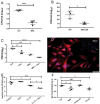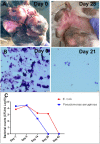Activated Mesenchymal Stem Cells Interact with Antibiotics and Host Innate Immune Responses to Control Chronic Bacterial Infections
- PMID: 28851894
- PMCID: PMC5575141
- DOI: 10.1038/s41598-017-08311-4
Activated Mesenchymal Stem Cells Interact with Antibiotics and Host Innate Immune Responses to Control Chronic Bacterial Infections
Abstract
Chronic bacterial infections associated with biofilm formation are often difficult to resolve without extended courses of antibiotic therapy. Mesenchymal stem cells (MSC) exert antibacterial activity in vitro and in acute bacterial infection models, but their activity in chronic infection with biofilm models has not been previously investigated. Therefore, we studied the effects of MSC administration in mouse and dog models of chronic infections associated with biofilms. Mice with chronic Staphylococcus aureus implant infections were treated by i.v. administration of activated or non-activated MSC, with or without antibiotic therapy. The most effective treatment protocol was identified as activated MSC co-administered with antibiotic therapy. Activated MSC were found to accumulate in the wound margins several days after i.v. administration. Macrophages in infected tissues assumed an M2 phenotype, compared to untreated infections which contained predominately M1 macrophages. Bacterial killing by MSC was found to be mediated in part by secretion of cathelicidin and was significantly increased by antibiotics. Studies in pet dogs with spontaneous chronic multi drug-resistant wound infections demonstrated clearance of bacteria and wound healing following repeated i.v. administration of activated allogeneic canine MSC. Thus, systemic therapy with activated MSC may be an effective new, non-antimicrobial approach to treatment of chronic, drug-resistant infections.
Conflict of interest statement
Two authors on the manuscript (V.J. and S.D.) are named as co-inventors on a patent that has been filed covering the antimicrobial stem cell technology.
Figures








Similar articles
-
Antibacterial activity of human mesenchymal stem cells mediated directly by constitutively secreted factors and indirectly by activation of innate immune effector cells.Stem Cells Transl Med. 2020 Feb;9(2):235-249. doi: 10.1002/sctm.19-0092. Epub 2019 Nov 8. Stem Cells Transl Med. 2020. PMID: 31702119 Free PMC article.
-
Activated Mesenchymal Stromal Cell Therapy for Treatment of Multi-Drug Resistant Bacterial Infections in Dogs.Front Vet Sci. 2022 Jun 23;9:925701. doi: 10.3389/fvets.2022.925701. eCollection 2022. Front Vet Sci. 2022. PMID: 35812842 Free PMC article.
-
The mesenchymal stromal cell secretome promotes tissue regeneration and increases macrophage infiltration in acute and methicillin-resistant Staphylococcus aureus-infected skin wounds in vivo.Cytotherapy. 2024 Nov;26(11):1400-1410. doi: 10.1016/j.jcyt.2024.06.007. Epub 2024 Jun 12. Cytotherapy. 2024. PMID: 38944795
-
How innate immunity proteins kill bacteria and why they are not prone to resistance.Curr Genet. 2018 Feb;64(1):125-129. doi: 10.1007/s00294-017-0737-0. Epub 2017 Aug 24. Curr Genet. 2018. PMID: 28840318 Free PMC article. Review.
-
New approaches to the treatment of biofilm-related infections.J Infect. 2014 Nov;69 Suppl 1:S47-52. doi: 10.1016/j.jinf.2014.07.014. Epub 2014 Sep 17. J Infect. 2014. PMID: 25240819 Review.
Cited by
-
Upregulation of CD14 in mesenchymal stromal cells accelerates lipopolysaccharide-induced response and enhances antibacterial properties.iScience. 2022 Jan 12;25(2):103759. doi: 10.1016/j.isci.2022.103759. eCollection 2022 Feb 18. iScience. 2022. PMID: 35141503 Free PMC article.
-
Combined adipose-derived mesenchymal stem cell and antibiotic therapy can effectively treat periprosthetic joint infection in rats.Sci Rep. 2023 Mar 9;13(1):3949. doi: 10.1038/s41598-023-30087-z. Sci Rep. 2023. PMID: 36894548 Free PMC article.
-
Mesenchymal Stromal Cells as Potential Antimicrobial for Veterinary Use-A Comprehensive Review.Front Microbiol. 2020 Dec 1;11:606404. doi: 10.3389/fmicb.2020.606404. eCollection 2020. Front Microbiol. 2020. PMID: 33335522 Free PMC article. Review.
-
Antibacterial activity of human mesenchymal stem cells mediated directly by constitutively secreted factors and indirectly by activation of innate immune effector cells.Stem Cells Transl Med. 2020 Feb;9(2):235-249. doi: 10.1002/sctm.19-0092. Epub 2019 Nov 8. Stem Cells Transl Med. 2020. PMID: 31702119 Free PMC article.
-
Evaluation of the Antimicrobial and Antibiofilm Effect of Chitosan Nanoparticles as Carrier for Supernatant of Mesenchymal Stem Cells on Multidrug-Resistant Vibrio cholerae.Infect Drug Resist. 2020 Jul 10;13:2251-2260. doi: 10.2147/IDR.S244990. eCollection 2020. Infect Drug Resist. 2020. PMID: 32765001 Free PMC article.
References
-
- Garwood CS, Steinberg JS. What’s new in wound treatment: a critical appraisal. Diabetes Metab Res Rev. 2015 - PubMed
Publication types
MeSH terms
Substances
Grants and funding
LinkOut - more resources
Full Text Sources
Other Literature Sources
Medical

